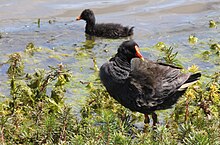| Moorhens Temporal range: Late Oligocene to recent
| |
|---|---|

| |
| Dusky moorhen, Gallinula tenebrosa | |
| Scientific classification | |
| Domain: | Eukaryota |
| Kingdom: | Animalia |
| Phylum: | Chordata |
| Class: | Aves |
| Order: | Gruiformes |
| Family: | Rallidae |
| Genus: | Gallinula Brisson, 1760 |
| Type species | |
| Fulica chloropus Linnaeus, 1758
| |
| Species | |
|
see text | |
| Synonyms | |
|
Edithornis | |
Moorhens—sometimes called marsh hens—are medium-sized water birds that are members of the rail family (Rallidae). Most species are placed in the genus Gallinula, Latin for "little hen."[1] They are close relatives of coots. They are often referred to as (black) gallinules. Recently, one of the species of Gallinula was found to have enough differences to form a new genus Paragallinula with the only species being the lesser moorhen (Paragallinula angulata).
Two species from the Australian region, sometimes separated in Tribonyx, are called "native hens" (also native-hen or nativehen).[2][3][4][5] The native hens differ visually by shorter, thicker and stubbier toes and bills, and longer tails that lack the white signal pattern of typical moorhens.[6][7]
- ^ Gallinula is the diminutive of gallīna ("hen"). It is anglicized gallinule in older zoological texts. "gallinule". Oxford English Dictionary (Online ed.). Oxford University Press. (Subscription or participating institution membership required.)
- ^ "Taxonomy update for 2017 - eBird". eBird. Retrieved 22 November 2018.
- ^ Gill, Frank; Donsker, David (eds.). "Taxonomy Version 2". IOC World Bird List (v14.1). IOC World Bird List. Retrieved 22 November 2018.
- ^ Pepperday, Martin. "Profile - Tasmanian Native Hen". UTAS Zoology Home. University of Tasmania. Archived from the original on 2 October 2006. Retrieved 22 November 2018.
- ^ Goldizen, Dr. "Tasmanian native hens share mates to get the best ground". The University of Queensland, Australia. The University of Queensland. Retrieved 22 November 2018.
- ^ Boles (2005)
- ^ "Parks & Wildlife Service - Native Hen, Tribonyx Mortierii". Parks & Wildlife Service. Tasmania Parks and Wildlife Service. Retrieved 22 November 2018.